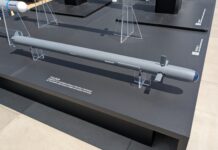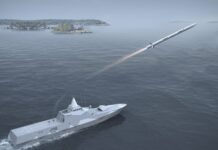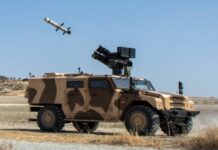Over the century of aviation, military airpower has changed dramatically. In the First World War, pilots and gunners used pistols, guns and dropped small bombs by hand from aircraft made of wood and cloth. In the 30 years that followed, bombers and weapons have become more sophisticated and powerful.
The sleek and shiny Enola Gay B-29 bomber that took off from the Mariana Islands in the Pacific Ocean to drop the first atomic bomb on Hiroshima, Japan, was the climax of this trend. Following World War Two, as fighter and bomber aircraft became ever more versatile and complex, so too were the weapons they carried. Bombs could navigate and optimise the attack profile by determining strike angle; smart fuses enabled proximity or delayed action, improving terminal effect with a conventional warhead, thus achieving maximum lethality without reverting to a nuclear option. With added propulsion, weapons also became more independent and have enabled airstrikes from a stand-off range, thereby reducing the risk associated with enemy air defences.
These changes have taken place over at least two decades, as militaries and defence companies struggle with the high cost of weapon development and acquisition. During the Cold War, armaments were developed as complete weapon systems, regardless of the cost of acquisition and fielding. The fall of the Berlin Wall brought the arms race to a stop, but the long war that began in 1991 has created a demand for affordable and effective aerial weapons that air forces can afford both from the economy of battle, crew safety, and collateral damage risk. The packaging of strike and reconnaissance capabilities with affordable, precision attack weapons, mostly small-sized bombs, rockets, and missiles, has addressed these needs. These techniques were perfected in recent years, with the extensive employment of drones for surveillance and attack.
However, as Iranian-backed non-state organisations entered the fray, large drones have proven relatively vulnerable to air defence weapons. They were forced to climb higher to operate above the ceiling of enemy fire. Although they were safer at these heights, drones are less capable of delivering the detailed imaging they obtained at the lower level. The advantages offered by the integration of drones and aircraft brought small and precise weapon systems designed for manned-unmanned teaming. These capabilities leverage the benefits of the unmanned platform that remove the risk of flying close to the enemy. Short decision cycles enable engagement in time-critical targets, with manned aircraft processing the information and employing weapons from the drone or other platforms launched from a stand-off range.
Doing More With Less
Since the collapse of the Soviet Union, the absence of near-peer forces has enabled Western armies to dominate the war zones they operated in, primarily due to their total air superiority. They could concentrate massive airpower, but since the irregular forces turned to urban guerrilla warfare and merged with the civilian population, targets have become elusive and rarely present themselves to enable aerial attack. To fight against such forces, airpower relied on persistent surveillance and developed short targeting cycles to address time-critical targets. Drones often performed reconnaissance missions since helicopters and surveillance aircraft proved too vulnerable flying at low-level while carrying out direct attacks. Other attack missions were carried out from high altitude by strike aircraft with a versatile weapons carrying capability. In recent regional and local conflicts in the Middle East (Syria, Iraq, and Yemen), Libya, Ukraine, and the Caucasus, all sides have turned to weaponised unmanned aerial systems to achieve decisive actions.
The increased threat from enemy air defences, particularly against vertical-lift aircraft and gunships, required changes in the weapon mix carried by low and slow flying platforms. This included increased precision and lethality, as enabled by turning the standard BAE Systems’ 2.75-inch rockets into the Advanced Precision Kill Weapon System (APKWS-II). This low-cost solution enables existing assets (helicopters, rocket launchers, and on-board fire control systems) to become more effective by engaging targets precisely at the maximum range (about 6 km) with minimal exposure. Since APKWS-II relies on the 2.75-inch standard, it is already cleared for operations on quite a few aircraft and helicopters, including UH-1Y, AH-1W, AH-1Z, Bell 407G, AH-64, Tiger, MH-60R, AV-8B, OV10, F16, and A10C. The weapon is undergoing integration on other manned and unmanned platforms, including MQ-8C, V22, AH-6, A29, F18, CN235, and AT-6. APKWS is currently fielded or selected for use by 12 air forces, including the US, UAE, Iraq, Qatar, the Philippines, Tunisia, Czech Republic, Thailand, Greece, India, Morocco, and Mexico.
Another new capability added to helicopters is the Common Launch Tube (CLT) developed by Systima Technologies. This tubular carrier launcher can host and deploy different aerial weapons that meet its dimensions and interface. This includes missiles, glide weapons, bombs, and sensors (such as unmanned aerial vehicles). Originally developed to meet special operations needs, CLT has been integrated with military transport aircraft (C-130), assault (UH-60), and scout (OA-6 and MD969) helicopters, enabling them to deploy a variety of new weapons and air-launched sensors without the need for lengthy integration processes.
The CLT can launch a rocket-powered weapon forward by aerial, ground, or naval platforms. It can also be used for ‘cold launch’ by ejecting the weapon backwards on aerial platforms. The rocket ignition or wing deployment is delayed to separate safely from the launching platform in this method. Typical weapons already deployed from CLT are Raytheon’s AGM-176 GRIFFIN missile and Dynetics’ GBU-69 Small Glide Munition (SGM) Stand-Off Precision Guided Munition (SOPGM). The latter offers an all-azimuth launch capability. At the same time, its deployable wing provides a significant stand-off range resulting in a large weapon footprint and a corresponding increase in armed overwatch area. Sensors deployed from CLT include the ALTIUS 600 mini-drone and COYOTE loitering weapon.
CLTs offer a versatile weapon carrying capability on several aircraft. CLT stacks are carried on the AC-130 gunship, enabling aft-ejection of weapons from the open load ramp. The MD696 light attack helicopter also uses a seven-tube stack configured for the aft-ejecting of weapons sideways, while the UH-60 or Unmanned Aircraft Systems (UAS) uses forward launch. SOCOM also plans to equip its future ‘Armed Overwatch’ light attack aircraft with CLTs to provide special operations forces with close air support.
The Air Force Special Operations Command (AFSOC) has developed the Tactical Off-Board Sensing capability (TOBS). For this mission, the ALTIUS 600 produced by the Area-I company is used. AC-130 gunships deploy the drones from CLTs to allow the crew to see the battlefield from afar or when their on-board sensor views are obscured. The drone’s live video feed is transmitted back to the gunship, where operators can manipulate picture framing, zoom levels, and positioning. The miniature drone remains overhead, maintaining a continuous scan for any surprises or threats until the weather situation improves and is no longer needed. AFSOC considers this capability affordable at a cost of US$100-150,000 per drone.
Like many other systems in SOCOM’s arsenal, the ALTIUS-600 gradually transforms into a versatile platform assuming additional missions. The mini drone weighs between 10-12 kg, depending on payload. It has a range of 450 km, with four hours of mission endurance. It carries different loads for reconnaissance, signals intelligence (SIGINT) missions, or a small warhead when used as a loitering weapon.
Strike Further
Other airpower enhancements include extended effects beyond the line of sight; this is enabled by guided missiles such as the SPIKE LR, ER, or NLOS. To launch their missiles, helicopters no longer have to expose themselves to the enemy. Fired from a ‘defilade’ position behind a hill, the missiles ascend to acquire and home in on their target using a data link to receive updates, confirmation, retargeting, or abort commands. Helicopter pilots rely on intelligence and targeting provided by other elements over the battlegroup shared network to operate these missions. Modern operational concepts also include the integration and teaming of manned and unmanned assets (MUM-T), where the helicopter aircrews use drones and joint attack teams on the ground. This concept was recently implemented in the South Korean MUM-T as part of the Light Attack Helicopters (LAH) reconnaissance helicopters expected to enter service in 2023 which will operate loitering missiles as integral weapons. This MUM-T concept is part of the LAH development pursued by Korea Aerospace Industries (KAI) in cooperation with IAI.
Minimising Collateral Damage
With improved precision, extended range, and higher survivability rates, guided air-launched weapons offer an increased probability of kill (PK). With better chances of mission success, warheads become compact, and facilitate smaller, lighter weapons. Such warheads offer target-focused lethality to reduce the risk of collateral damage and safety radius, enabling air support to strike closer to friendly forces. Some warheads are designed for scalable effects, matching the explosive impact to the mission profile. They are designed to minimise lethality and fragmentation beyond a certain kill radius by using composite materials and frangible bomb cases. This is particularly important for weapons used in urban areas.
Guided weapons designed to strike with high precision may cause collateral damage when they bounce from a hard surface. To avoid this risk, advanced multi-purpose and concrete penetrating bombs are designed with materials and geometries to minimise bouncing and move inside hard structures in straight lines. Modern fuses are equipped with ‘void counters’ to delay the warhead activation until the bomb reaches a specific floor or room inside the building or underground bunkers.
In the past, these capabilities were reserved for powerful and strategic weapons and cruise missiles, but today they can be used with standard weapons like the Joint Direct Attack Munition (JDAM). Boeing is also developing a long-range version of the weapon called the Powered JDAM, adding an engine to extend its range by 20 times the conventional glide version of the weapon. The new weapon combines a 500-pound warhead, a wing kit, and a propulsion module into the same form factor as a 2,000-pound bomb. Once fully developed, the weapon would offer a lower-cost alternative to cruise missiles for stand-off attack, adapting a conventional bomb for attacking targets in a contested battlespace.
Powered JDAM aims to take the proven JDAM and make it effective in anti-access, area-denial environments, so it has the range to stand outside that engagement zone. The system could also be used as a decoy. Currently, decoys use the AD-160 Miniature Air Launched Decoy (MALD) to mimic the signature of an attack aircraft or a group of aircraft, causing enemy radar and air defences to engage the decoys and expose themselves to an attack. Fitting a weapon with a decoy payload enhances this capability offering a more versatile kinetic-non kinetic attack capability.
Unlike tactical strike weapons, larger and powered cruise missiles offer the strategic ‘Deep Strike’ capability. They employ low-level flight and low observable techniques to evade enemy air defences, penetrate and open breaches in Anti Access Area Denial (A2AD) arrays protecting the enemy airspace. Follow-on strikes employ tactical strike weapons that are also launched from a stand-off range. The modern designs use compact and networked armaments to saturate enemy defence and deliver precision effects using swarm behaviour.
Smaller and Smarter
With aerial weapons becoming smaller, aircraft loadout is increased, enabling a small number of aircraft to carry out large attacks. Small air-launched weapons are equipped with glide kits to strike targets at distances of 100 km. Designed around the 250 lb weight class, the Boeing GBU-39 Small Diameter Bomb (SDB), Rafael SPICE 250, and Safran/Diehl HUSSAR employ specially designed quad-launchers that carry the weapon, interface with the aircraft’s armament control system, and provide a datalink to update the munitions in flight. A fully-loaded Cobham Mission Systems’ BRU-61/A SDB quad-launcher weighs 1,460 lb which favourably compares with a single 2,000 lb bomb, offering 4x strike capacity to maximise weapon load-out even with smaller aircraft. To extend the range even further, powered versions of those small gliding weapons are under development – the SPICE-250 ER from Rafael and MBDA’s SPEAR III are two examples. Both are equipped with a small turbojet to sustain the weapon’s flight to 140-150 km, a range considered beyond the effective range of most surface-to-air missile systems.
Both weapons use a two-way data link for in-flight retargeting and abort functions. Both are versatile but reflect different conceptual approaches to guidance and targeting. SPEAR III uses inertial and GPS guidance for mid-course navigation and millimetric wave radar or infrared or a semi-active laser seeker for the terminal attack. Independent of GPS navigation, SPICE 250 uses inertial navigation and electro-optic scene-matching, and employs Artificial Intelligence (AI) algorithms for autonomous navigation and terminal attack. The EO sensor also facilitates Automatic Target Recognition (ATR), Automatic Target Acquisition (ATA), and Moving-Target-Detection thereby enabling the SPICE to engage mobile and relocated targets.
The ATR feature enables the SPICE 250 to learn the specific target characteristics of the mission using advanced AI and deep-learning technologies. Before or during flight, the target type, location, and strike attributes are defined for each weapon, either by the automated mission planning or by the pilot. The weapons fly towards their targets, using their INS for initial navigation. When approaching the target area, they use their ATA and ATR modes to detect and recognise their assigned targets and determine precise aim-points. Each weapon homes in on the pre-defined target, either autonomously or with a human-in-the-loop, aided by the ATR algorithm.
“This future capability will offer users the unique combination of a combat-proven system with unparalleled state-of-the-art technologies, while taking advantage of existing infrastructure, without the need for a new integration,” Alon Shlomi, VP, and head of Rafael’s air-to-surface systems directorate said. “The significantly-enhanced stand-off range will enable pilots greater operational manoeuvrability, safety, and mission assurance,” he added.
Another family of intelligent weapons is under collaborative development by MBDA and the Tawazun company of the UAE, as announced at the IDEX 2021 defence exhibition. Currently, at the pre-development phase, the joint team will study several concepts before reaching its development. Originally the SmartGlider family included two basic glide vehicles – light and heavy platforms. SmartGlider Light is designed as a low-cost weapon that allows first-day-entry of heavily defended airspace by saturating and destroying enemy air defences. SmartGlider Heavy relies on the same concept but features a significantly larger warhead capable of delivering large penetration warheads. This allows for the engagement of a wide range of complex fixed targets. Six SmartGliders will be carried on each ‘Hexabomb Smart Rack’ (HSL), enabling the deployment of intelligent, networked, and autonomous weapons to carry out swarm-like attacks. MBDA is also studying developing a compact cruise missile known as SMART CRUISER, based on a powered version of the weapon.
The Networked Swarm
The next step is connecting the individual weapons to achieve a Networked, Collaborative, and Autonomous (NCA) attack. In the past two years, the Golden Horde programme at the US Air Force Research Laboratory (AFRL) explored intelligent guided weapons as part of the ‘Horde Vanguard’ programme using specially modified Collaborative Small Diameter Bombs (CSDB). The weapon completed the flight test programme at White Sands Missile Range, New Mexico, in May 2021.
During the third and last phase of the flight test, two F-16s from the 96th Test Wing Eglin Air Force Base simultaneously released six CSDB weapons. Four were released from one aircraft and two from the other. During their flight, all weapons established radio communications with each other using the L3Harris Banshee 2 radio network. A ground station also participated in the network, delivering in-flight target updates (IFTU). This phase of the test demonstrated the ability to scale up the number of nodes required to accomplish the mission.
Such IFTU messages are sent from outside the weapon swarm, and direct the swarm to pursue another target. It demonstrated the ability of Golden Horde weapons to interface with the larger Joint All-Domain Command and Control network (JADC2), a capability considered critical for future NCA operations. The final test objective had two weapons perform a synchronised time-on-target (STOT) attack on a single target location. “The Golden Horde team is blazing an exciting new path for air-delivered weapons,” said Maj. Gen. Heather Pringle, AFRL commander, adding that “These technologies are completely changing the way we think about weapon capabilities, much like the laser-guided bomb did several decades ago. Golden Horde and technologies like this will enable the Department of the Air Force to overcome many of its current and future challenges, and we’re just beginning to unfold all the possibilities.” The next phase, called the Colosseum, rapidly integrates, develops, and tests transformational NCA weapon technologies for future warfighting opportunities.
While the Air Force doesn’t appear to have any current plans to field the CSDBs themselves as operational weapons, further developments of the technology that it is now trialling as part of the Golden Horde programme could find a way into frontline weapons. The AGM-158 Joint Air-to-Surface Standoff Missile (JASSM), the ADM-160 Miniature Air-Launched Decoy, and the GBU-53/B STORMBREAKER have all been mentioned in the past as potential candidates for this swarming technology.
Weapons for Multi-Domains
The 21st century battle planner can no longer rely on total aerial superiority, at least not in the first phase of a conflict. Instead, air and naval forces are required to operate within a challenging battlespace, dominated by anti-access area-denied capabilities. To fight in these conditions, forces employ a Multi-Domain Warfighting doctrine where each force is prepared to engage the enemy’s critical elements, with or without the support of other forces. Fighting in the Multi-Domain battlespace of the 21st century requires land, naval, and air forces to act and overmatch the enemy in all domains. To do that, weapons that were designed for a specific purpose are transformed for use in other domains.
Several weapon systems are already associated with this trend, including the AGM-176 GRIFFIN missile enabled by the multi-purpose CLT as a launcher, versions of the SDB and AARGM missiles, turned into the Ground-Launched Small Diameter Bomb (GL-SDB) and Ground-Launched Advanced Anti-Radiation Guided Missile (GL-AARGM) by using rocket boosters to reach the initial altitude, and the APKWS rockets that have now been adapted to operate on ground vehicles using the FLETCHER multiple launcher system developed by Arnold Defence. Another example is the MBDA BRIMSTONE guided missile that uses a canister as a carrier launcher deployed on manned and unmanned combat ground vehicles.
These weapon systems were initially developed for aerial platforms and converted to land and naval domains. Other weapons, primarily missiles and rockets, were converted from the land or naval domains for aerial weapons. These include the Kongsberg /Raytheon Naval Strike Missile (NSM) and Elbit Systems/IAI RAMPART guided rocket. According to some assessments, the Russian 9M723 (ISKANDAR) surface-surface missile has been adapted into the first operational air-launched land-attack hypersonic missile known as the Kh-47M2 KINZHAL. In 2019, the missile reportedly entered operational deployment with Russian MiG-31 strike fighters and was also planned to equip part of the Russian Tu-22M3 long-range bomber force enabling a 2,000 km strike range.
Multi-domain capability also relates to air-launched weapons able to engage the enemy in several domains, such as kinetic and electronic attacks. There are several examples of such weapons, particularly in the loitering weapon class. The ALTIUS-600 can carry the MoRFIUS high-power microwave emitter, developed by Lockheed Martin as a counter-drone weapon. Using Elbit Systems’ electronic attack payload, the ALTIUS-600 can be fitted with a powerful mini-generator and MicroSpear electronic surveillance and attack system.
The MINI HARPY from IAI also uses a combination of a warhead, a passive electronic seeker, and an electro-optical sensor to detect active enemy radars and other emitters. The EO sensor is used to guide the loitering weapon to attack a target even if it ceases transmitting. Another example is the SPEAR RF from MBDA which can be used as part of a swarm attack by SPEAR III missiles to engage enemy air defences with an electronic attack. At the same time, other SPEARs pursue their targets kinetically.
Attritable or Expendable?
Throughout their evolution, air-launched weapons have been designed as expendable assets. Yet, in recent years developers and users consider some of their unmanned platforms as expendable (missiles and other ‘suicide’ weapons) or ‘attritable’, meaning they are regarded as expendable if they do not survive the battle. Attritable weapons are already part of the development of future air combat systems in the US and Europe. A ground-launched long-range aircraft, the XQ-58A VALKYRIE is designed for high speed and agile manoeuvrability, enabling it to carry different sensors, weapons, and payloads to perform various missions with maximum operational flexibility to the war fighter.
The XQ-58A, developed and built by Kratos Defence, addresses AFRL’s Low Cost Attritable Aircraft Technology (LCAAT) programme with the goal of breaking the escalating cost trajectory of tactical manned aircraft through low-cost procurement. It is designed to be significantly cheaper to buy and operate than traditional piloted or unpiloted aircraft. It is the first example of a class of UAVs developed through this cost- and time-saving process.
In Europe, this capability is considered for the future air warfare plans as part of the Future Combat Air System. The Remote Carriers concept is being developed by MBDA and Airbus as part of FCAS, the sixth-generation aircraft which is the manned element in the programme expected to begin test flights in 2026. Acting as force multipliers, Remote Carriers are UAVs designed to reduce the risks for manned aircraft by taking over specific air operations’ roles in high-risk environments, thereby providing new air warfare capabilities and teaming in combination with and coordinated by other manned air assets.
Remote Carriers
Several types of Remote Carriers are being studied, including expendable swarms, possibly followed by more sophisticated attritable assets, providing a wide scope of potential missions to better support a safer penetration of manned aircraft into a hostile environment. Capable of “Cross-Platform Mission Management”, the Remote Carriers will complement and augment manned fighter aircraft capabilities performing in close cooperation though with a high degree of automation and autonomy to improve mission performance in high intensity conflicts and increase the combat mass to better compensate limited numbers of sophisticated manned fighter aircraft.
Designed as large, unmanned platforms that join a combat manned-unmanned formation, the stealthy or supersonic horde of remote carriers will be launched from combat or transport aircraft, from the ground or surface ships. They will cooperate with other armaments and platforms, equipped with networking, infrared, and radio frequency sensors with data fusion and AI to enable automated target identification in complex environments.
In the foreseeable future, remote carriers deploying swarms of large and small guided missiles, supported by electronic attack weapons, will be able to carry the fight into the highly defended target space, enabling manned aircraft to stay out of range of air defences while managing the battle from afar.
Tamir Eshel





![Ripples in the air, rupture in the ether Pictured: 1L269 Krasukha-2 jamming system. Since 2008, Russia has greatly expanded its EW capabilities, and since 2022 it has gained valuable direct experience contesting the EMS in Ukraine, where continuous innovation occurs over very short timescales. [RecoMonkey]](https://euro-sd.com/wp-content/uploads/2025/07/1L269-Krasukha-2_RecoMonkey-Kopie-218x150.jpg)





